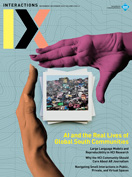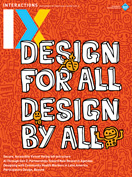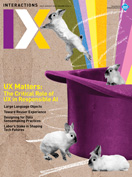Table of Contents
VOLUME XXVI.3 May - June 2019
-
WELCOME
-
Us, them, who, how
Gilbert Cockton, Simone Barbosa
Human-focused design (HFD) needs empathy, but who needs it most? Just the users, or do researchers and designers merit some too? Following her Ps & Qs column on impostor syndrome a year ago, Elizabeth Churchill shares advice on looking after ourselves. In the Business of UX forum, Dirk Knemeyer…
-
-
Demo Hour
-
Demo hour
Dennis Siegel, Joran van der Sluis, Wessel Fletterman, Mark Zwart, Lewis Hornby, Jordan Hamilton, Liam Stephenson
1. Electromagnetic Harvester We are surrounded by electromagnetic fields, both natural and artificial. Many are created as by-products of our appliances and electrical infrastructure. Some can be transformed into usable current by means of coils and high-frequency diodes. The Electromagnetic Harvester is designed to tap into electromagnetic fields to…
-
-
What are you reading?
-
What are you reading? Wendy Moncur
Wendy Moncur

My choice of reading matter usually follows a certain pattern: fiction with a strong storyline and well-drawn characters, grounded in a real-world context that I know little about. This context might be the Forbidden City in China as the last emperor's reign disintegrated (Empress Orchid by Anchee Min), crime…
-
-
Blog@IX
-
Automatizing the power grid
Catherine Bischofberger

Relations between humans and machines have become rather fraught. A growing number of anxieties crystallize around the use of robots and automation in various industries, not to mention our homes. Things were quite different in the late 19th century, when the introduction of the first machines was expected to…
-
-
How was it made?
-
How was it made? Social robotic donuts
Harvey Bewley, Laurens Boer

Describe what you made. We created an air-actuated, donut-shaped social robot. Our intention was to purposefully move away from typical human or animal form mimicry, focusing instead on elastic expression, ambiguous form, and playful behaviors. Stable and solid looking, the smooth and symmetrical donut is a shape distinct from…
-
-
Columns
-
Impostor syndrome and burnout: Some reflections
Elizabeth Churchill

Last year I wrote a column that asked, "Is There a Fix for Impostor Syndrome?" [1]. Since it was published in May 2018, I have received many emails and had many conversations about impostor syndrome—about the conditions in which it develops and thrives, about ways one can recognize it…
-
Nest rage
Jonathan Bean

Not long ago I spent the entirety of a weekend morning trying to fix my thermostat. The whole experience, which involved an extended online chat with a chipper but ultimately useless series of customer service representatives, was quietly infuriating. It was one of those moments, like dealing with a…
-
#ItsNotAboutYou
Greg Nudelman

The Abracadabra series invites us to share a heartfelt wish for the future of our discipline. My big wish for HCI/UX/UI is to tell my people something that took me my entire career to figure out: It's not about you. As Marvel fans may remember, these are the words…
-
-
Day in the Lab
-
Wellness technology lab
Andrea Parker

How do you describe your lab to visitors? The Wellness Technology Lab at Northeastern University examines how digital technologies can be designed to achieve health equity, that is, fair opportunities for all populations to achieve wellness. We specifically focus on vulnerable and marginalized populations—those groups in society who disproportionately…
-
-
Forums
-
More-than-human participation: Design for sustainable smart city futures
Rachel Clarke, Sara Heitlinger, Ann Light, Laura Forlano, Marcus Foth, Carl DiSalvo

Out of necessity or choice, people and wildlife are increasingly living side by side in urban environments. As more species live together in cities, significant environmental challenges associated with high-density living, poor resource management, habitat loss, and pollution arise. These conditions can be toxic for humans and non-humans alike.…
-
The remarkable illusions of technology for social good
Nithya Sambasivan

Since information and communication technologies (ICTs) first became available to the public more than 20 years ago, social good has been an important application area for computing. Today, more than ever, there is widespread momentum in deploying technologies for social good across computing domains such as user-facing interfaces, networking…
-
From medicalized to mundane self-care technologies
Francisco Nunes

Living with chronic conditions is extremely complex and demanding. Patients and carers often need to monitor symptoms, manage treatment, and deal with disability and other impacts, while accepting that they will continue having these issues throughout their lives. Care in these contexts happens mostly at home and in everyday…
-
Creative Next: AI, automation, and the practice of user experience design
Dirk Knemeyer, Jonathan Follett

The word automation conjures an image of a factory full of robots, a modern marvel symbolizing both technological progress and the regression of working-class opportunities and lifestyles. But our notion of automation generally remains ossified in this physical, machine-replaces-labor frame. We don't think of automation in the realm of…
-
Don’t blame the user: Toward means for usable and practical authentication
Albrecht Schmidt

The use of usernames and passwords for authentication is not secure! And we have known this for a very long time. Nevertheless, usernames and passwords are widely used, as they are easy to implement for developers. The way we deal with this problem is to blame the user for…
-
-
Community square
-
The volunteers at the heart of our publications
Helena Mentis

In order to increase access to our publications across more types of mobile and assistive devices, ACM is in the midst of a change to the underlying format of our scholarly publications (i.e., journals and conference archival papers). The goal is to create a more flexible and resilient archive…
-
-
Features
-
Special topic: HCI in the Arab world - introduction
Shaimaa Lazem, Ebtisam Alabdulqader, Mohamed Khamis

HCI in the Arab World The Arab world consists of 22 countries stretched across two continents (Asia and Africa), making it one of the world's most influential territories. Besides sharing the same official language, Arab countries share a strong history dominated by the early colonialism era. Cultural values vary…
-
‘My guardian did NOT approve!’ Stories from fieldwork in Saudi Arabia
Soud Nassir, Adel Al-Dawood, Elham Alghamdi, Eman Alyami

Recently, the ArabHCI (https://arabhci.org/) initiative conducted a workshop that sought to "explore participatory design methods to engage with Arab communities" [1], encouraging researchers and practitioners to bring forward their stories, experiences, and lessons learned from conducting qualitative fieldwork and designing in the Arab world. Similarly, the workshop included discussions…
-
HCI of Arabia: The challenges of HCI research in Egypt
Galal Galal-Edeen, Yasmeen Abdrabou, Maha Elgarf, Hala Hassan

The user-centered design and evaluation of technology within an Arab culture such as Egypt presents a unique set of challenges. For example, many designers and users in Egypt are not used to open feedback and dialogue. In addition, finding participants for design evaluation is difficult—particularly for special user groups…
-
What is (un)acceptable? Thoughts on social acceptability in HCI research
Marion Koelle, Thomas Olsson, Robb Mitchell, Julie Williamson, Susanne Boll

Technology is changing the way we experience our lives. Interactive and increasingly intelligent technologies allow us to tackle challenges previously considered unsolvable and to augment our capabilities of sensing, communication, and even creativity. Examples include head-mounted displays and smart personal services for ubiquitous information access, and autonomous vehicles for…
-
What is participation? Emerging challenges for participatory design in globalized conditions
Max Krüger, Ana Duarte, Anne Weibert, Konstantin Aal, Reem Talhouk, Oussama Metatla

At its very core, participatory design (PD) is concerned with issues of power [1]. Since PD's earliest applications, the aim has been to make voices heard and provide agency through participation in the design of technological artifacts, infrastructures, and processes. But participation does not happen by itself, and what…
-
-
Cover story
-
The business of UX management
Daniel Rosenberg

The success of design-driven companies such as Apple, BMW, and Disney has motivated CEOs across all product sectors to proclaim that their companies are becoming more design-centric and customer-focused. During quarterly status broadcasts and other meetings, UX practitioners routinely witness their executives espousing the delivery of quality experiences as…
-
-
Special topic: HCI in the Arab world
-
Special topic: HCI in the Arab world - introduction
Shaimaa Lazem, Ebtisam Alabdulqader, Mohamed Khamis

HCI in the Arab World The Arab world consists of 22 countries stretched across two continents (Asia and Africa), making it one of the world's most influential territories. Besides sharing the same official language, Arab countries share a strong history dominated by the early colonialism era. Cultural values vary…
-
‘My guardian did NOT approve!’ Stories from fieldwork in Saudi Arabia
Soud Nassir, Adel Al-Dawood, Elham Alghamdi, Eman Alyami

Recently, the ArabHCI (https://arabhci.org/) initiative conducted a workshop that sought to "explore participatory design methods to engage with Arab communities" [1], encouraging researchers and practitioners to bring forward their stories, experiences, and lessons learned from conducting qualitative fieldwork and designing in the Arab world. Similarly, the workshop included discussions…
-
HCI of Arabia: The challenges of HCI research in Egypt
Galal Galal-Edeen, Yasmeen Abdrabou, Maha Elgarf, Hala Hassan

The user-centered design and evaluation of technology within an Arab culture such as Egypt presents a unique set of challenges. For example, many designers and users in Egypt are not used to open feedback and dialogue. In addition, finding participants for design evaluation is difficult—particularly for special user groups…
-
What is participation? Emerging challenges for participatory design in globalized conditions
Max Krüger, Ana Duarte, Anne Weibert, Konstantin Aal, Reem Talhouk, Oussama Metatla

At its very core, participatory design (PD) is concerned with issues of power [1]. Since PD's earliest applications, the aim has been to make voices heard and provide agency through participation in the design of technological artifacts, infrastructures, and processes. But participation does not happen by itself, and what…
-
-
Calendar
-
Calendar
INTR Staff

Featured conferences ICMI '19 (Suzhou, China) Conference Dates: October 14–18, 2019 https://icmi.acm.org/2019/ Submission Deadlines Abstracts: May 1, 2019 Full papers: May 7, 2019 ICMI is the premier international forum for multidisciplinary research on multimodal human-human and human-computer interaction, interfaces, and system development. The conference focuses on theoretical and empirical…
-
-
Exit
-
Cat exploit
Dennis Siegel

Contributor: Dennis Siegel Curator/Editor: Anne Spaa Genre: More-than-human-computer interaction How secure are our home networks against wardriving stray cats? ©2019 ACM1072-5520/19/05$15.00 Permission to make digital or hard copies of all or part of this work for personal or classroom use is granted without fee provided that copies are…
-



